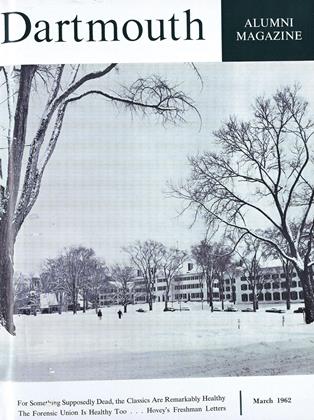By Inez and Marshall McClintock '26. Washington: Public Affairs Press, 1961. 480 pp. $8.00.
Beginning in Colonial times, the development of the toy industry in the United States is here reviewed in detail through 1900. The recent period, for which other documentation is readily available, is briefly sketched. An alphabetical list of toy manufacturers in the United States before 1900 records the period of their activity and their major products. I like, a full bibliography with helpful annotations, but this is a personal bias. The bibliography is, technically, adequate. A good index ends the book.
Although a good deal of human interest material has crept in, this is basically a monumental compilation of data on the history of the manufacture of toys. The authors worked three years in museums and libraries and interviewed toy manufacturers, their friends, and descendants. Their obvious conclusion is clearly outlined: children's toys reflect adult interests. In war time they go bang bang, and when adults turn to the psychiatrist's couch their children's toys are pre-tested by a psychologist.
Typical is the delightful story of the first Teddy bear, named for Theodore Roosevelt, who on a hunting trip refused to shoot a chained bear cub. The authors do not attempt to explain why children continue to like the Teddy bear long after the political implication has ceased to make it topical.
The most valuable portion of the book is the large number of half-tone illustrations. Reproductions of line drawings, printed matter and designs of high contrast are very adequate. Photographs in which there is a wide range of light and shadow have unfortunately suffered considerably.
As a museum man, I am particularly thrilled with this volume, for with it we can hope to date many of the children's toys in our collection. Now all I need is a student curator to do the work.
 View Full Issue
View Full Issue
More From This Issue
-
 Feature
FeatureTHE CLASSICS
March 1962 By NORMAN A. DOENGES -
 Feature
Feature...AND MANY DARTMOUTH YESTERDAYS
March 1962 By Edward Connery Lathem '51 -
 Feature
FeatureDartmouth's Debaters Are Arguing Themselves Into National Renown
March 1962 By HAROLD F. BRAMAN '21 -
 Feature
FeatureFund Goal: $1,250,000
March 1962 -
 Feature
FeatureTrustees and Councilors Hold a Combined Meeting
March 1962 -
 Feature
FeatureSome Members of the Board...
March 1962
ALFRED F. WHITING
Books
-
 Books
BooksFACULTY PUBLICATIONS
March, 1922 -
 Books
BooksDeep Trouble
SEPTEMBER | OCTOBER 2020 -
 Books
BooksTHE ISLANDS
June 1936 By Allan Macdonald -
 Books
BooksANY OLD WAY YOU CHOOSE IT: Rock and Other Pop Music, 1967-1973
March 1974 By J. MICHAEL STUART '71 -
 Books
BooksTHE NATURE WRITERS, A GUIDE TO RICHER READING
February 1939 By Robert McKennan '25 -
 Books
BooksMAKE YOUR OWN MOVIES. (FOR FUN AND PROFIT).
June 1939 By S. C. H.





